【高级课程笔记】—— Echarts高级应用(二)
一、视觉映射

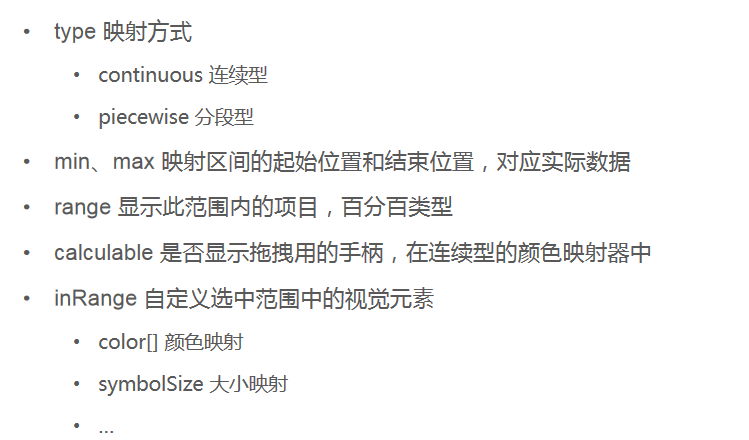
注:visualMap 以前叫dataRange,如果你看到了比较老的教程或博客,里面有dataRange,要知道那就是视觉映射 visualMap
<!DOCTYPE html>
<html lang="en">
<head>
<meta charset="UTF-8">
<title>视觉映射</title>
<style>
#main{
margin: 20px;
width: 800px;
height: 500px;
}
</style>
</head>
<body>
<!--建立dom 容器-->
<div id="main"></div>
<!--引入echarts-->
<script src="./js/echarts.min.js"></script>
<script>
// 基于准备好的dom,初始化echarts实例
const myChart = echarts.init(document.getElementById('main'));
//数据源
const source = [
//x y z w
[2, 1, 10, 90],
[4, 2, 20, 80],
[6, 3, 30, 70],
[8, 4, 40, 60],
[10, 5, 50, 50],
[12, 6, 60, 40],
[14, 7, 70, 30],
[16, 8, 80, 20],
[18, 9, 90, 10],
];
//颜色范围
const color=['#70ad47', '#c00000'];
// 指定图表的配置项和数据
const option = {
tooltip: {},
/*绘图区*/
grid:{
left:100
},
/*x 轴*/
xAxis: {},
/*y 轴*/
yAxis: {},
/*数据集*/
dataset:{source},
/*
* visualMap 视觉映射 {}
* type 映射方式
* continuous 连续型
* piecewise 分段型
* min 映射区间的起始位置,如0
* max 映射区间的结束位置,如90
* range [] 显示此范围内的项目(在连续型中有效),百分百类型,如[0,100]
* calculable 是否显示拖拽用的手柄
* inRange 自定义映射范围
* color[] 颜色映射
* symbolSize[] 大小映射
*
* */
visualMap:{
type:'continuous',
// type:'piecewise',
min:0,
max:100,
range:[0,90],
calculable: true,
inRange:{
color,
symbolSize:[10,60],
},
// dimension:2,
dimension:3
},
/*系列列表*/
series: [
{
name: '视觉映射',
type: 'scatter',
encode:{
tooltip:[0,1,2]
}
},
]
};
// 使用刚指定的配置项和数据显示图表。
myChart.setOption(option);
</script>
</body>
</html>

二、事件
ECharts 如何监听事件

<!DOCTYPE html>
<html lang="en">
<head>
<meta charset="UTF-8">
<title>事件</title>
<style>
#main{
margin: 20px;
width: 700px;
height: 500px;
}
</style>
</head>
<body>
<!--建立dom 容器-->
<div id="main"></div>
<!--引入echarts-->
<script src="./js/echarts.min.js"></script>
<script>
// 基于准备好的dom,初始化echarts实例
const myChart = echarts.init(document.getElementById('main'));
// 指定图表的配置项和数据
const option = {
xAxis: {
data: ["衬衫","羊毛衫","雪纺衫","裤子","高跟鞋","袜子"]
},
yAxis: {},
series: [{
name: '销量',
type: 'bar',
data: [5, 20, 36, 10, 10, 20]
}]
};
// 使用刚指定的配置项和数据显示图表。
myChart.setOption(option);
/*
* 使用on 方法绑定click点击事件
* */
myChart.on('click',function(param){
console.log(param)
})
</script>
</body>
</html>

鼠标事件有哪些

组件交互事件的监听
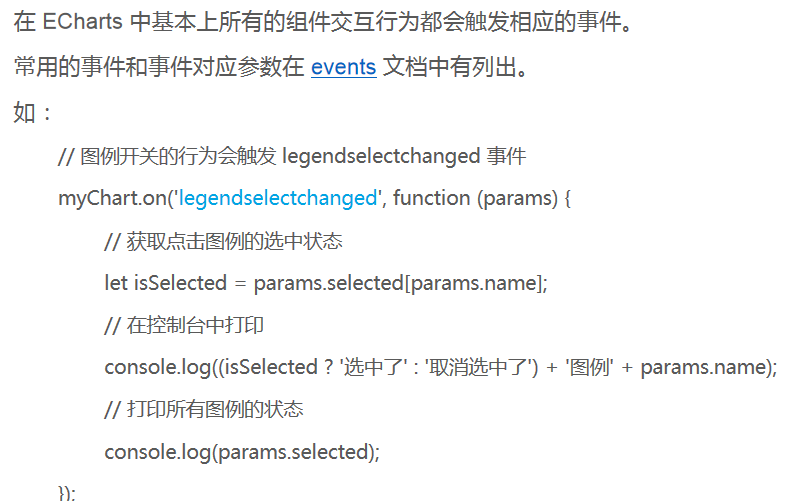
<!DOCTYPE html>
<html lang="en">
<head>
<meta charset="UTF-8">
<title>事件</title>
<style>
#main{
margin: 20px;
width: 700px;
height: 500px;
}
</style>
</head>
<body>
<!--建立dom 容器-->
<div id="main"></div>
<!--引入echarts-->
<script src="./js/echarts.min.js"></script>
<script>
// 基于准备好的dom,初始化echarts实例
const myChart = echarts.init(document.getElementById('main'));
// 指定图表的配置项和数据
const option = {
legend:{
data:['销量','库存']
},
xAxis: {
data: ["衬衫","羊毛衫","雪纺衫","裤子","高跟鞋","袜子"]
},
yAxis: {},
series: [{
name: '销量',
type: 'bar',
data: [5, 20, 36, 10, 10, 20]
},{
name: '库存',
type: 'bar',
data: [3, 4, 8, 3, 7, 5]
}]
};
// 使用刚指定的配置项和数据显示图表。
myChart.setOption(option);
/*
* 使用on 方法绑定legendselectchanged 图例开关点击事件
* */
myChart.on('legendselectchanged',function(param){
console.log(param)
})
</script>
</body>
</html>
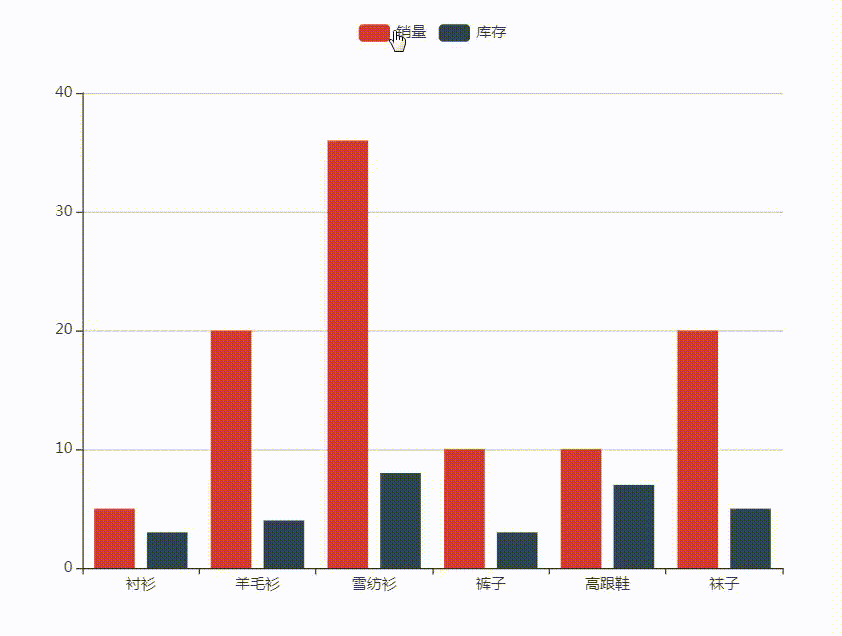
代码触发 ECharts 中组件的行为
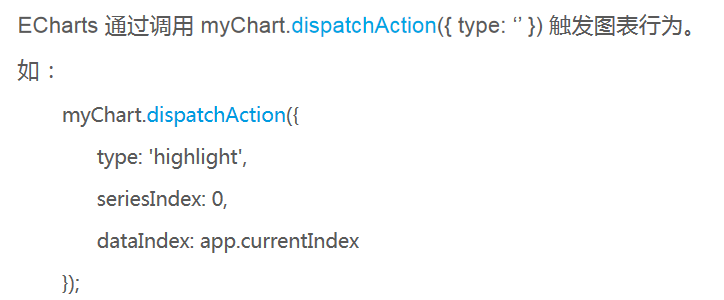
<!DOCTYPE html>
<html lang="en">
<head>
<meta charset="UTF-8">
<title>事件</title>
<style>
#main{
margin: 20px;
width: 700px;
height: 500px;
}
</style>
</head>
<body>
<!--建立dom 容器-->
<div id="main"></div>
<!--引入echarts-->
<script src="./js/echarts.min.js"></script>
<script>
// 基于准备好的dom,初始化echarts实例
const myChart = echarts.init(document.getElementById('main'));
// 指定图表的配置项和数据
const option = {
title: {
text: '饼图程序调用高亮示例',
left: 'center'
},
tooltip: {
trigger: 'item',
formatter: '{a} <br/>{b} : {c} ({d}%)'
},
legend: {
orient: 'vertical',
left: 'left',
data: ['直接访问', '邮件营销', '联盟广告', '视频广告', '搜索引擎']
},
series: {
name: '访问来源',
type: 'pie',
radius: '55%',
center: ['50%', '60%'],
data: [
{value: 335, name: '直接访问'},
{value: 310, name: '邮件营销'},
{value: 234, name: '联盟广告'},
{value: 135, name: '视频广告'},
{value: 1548, name: '搜索引擎'}
],
/*鼠标划上的状态*/
emphasis: {
itemStyle: {
shadowBlur: 10,
shadowOffsetX: 0,
shadowOffsetY: 10,
shadowColor: 'rgba(0, 0, 0, 0.5)'
}
}
}
};
// 使用刚指定的配置项和数据显示图表。
myChart.setOption(option);
/*当前索引*/
let ind=0;
/*获取系列数据的长度*/
let len =5;
/*使用dispatchAction 方法高亮并提示一个扇形
* type 触发的行为类型
* highlight 高亮
* showTip 显示提示
* downplay 取消高亮
* hideTip 取消提示
* seriesIndex 系列索引,用于寻找系列列表中的某个系列
* dataIndex 数据所有,用于寻找系列中的某个元素
* */
myChart.dispatchAction({
type:'highlight',
seriesIndex:0,
dataIndex:ind
});
myChart.dispatchAction({
type:'showTip',
seriesIndex:0,
dataIndex:ind
});
/*建立时间监听器*/
setInterval(function(){
myChart.dispatchAction({
type:'hideTip',
seriesIndex:0,
dataIndex:ind
});
myChart.dispatchAction({
type:'downplay',
seriesIndex:0,
dataIndex:ind
});
ind++;
if(ind===len){ind=0}
myChart.dispatchAction({
type:'highlight',
seriesIndex:0,
dataIndex:ind
});
myChart.dispatchAction({
type:'showTip',
seriesIndex:0,
dataIndex:ind
});
},1000)
</script>
</body>
</html>
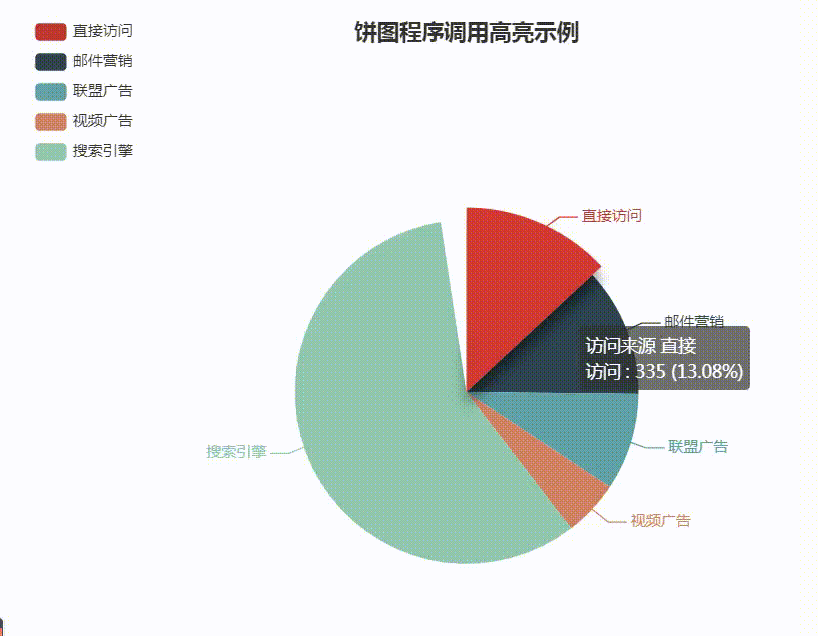
三、富文本标签
富文本标签,就是内容丰富的文本标签。
在许多地方(如图、轴的标签等)都可以使用富文本标签。例如:
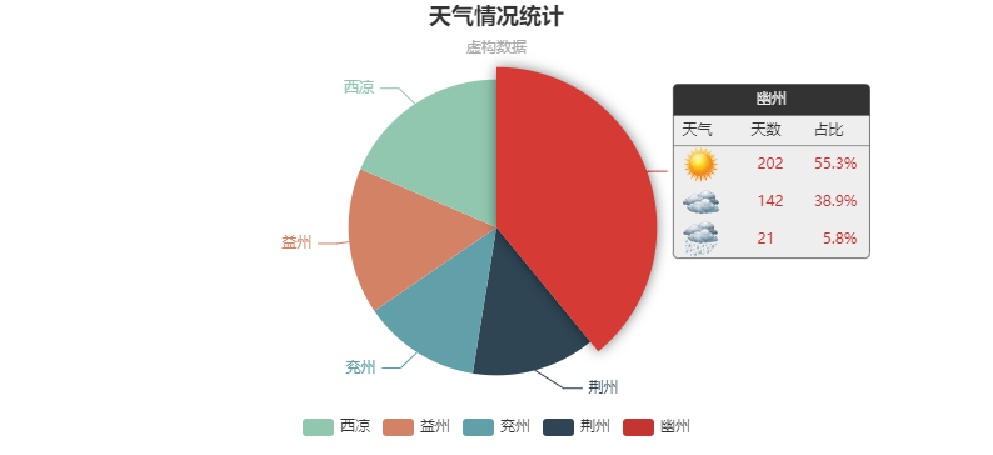
文本块和文本片段
- 文本块(Text Block):文本标签块整体。
- 文本片段(Text fragment):文本标签块中的部分文本。
文本标签的属性可以参考label:https://www.echartsjs.com/zh/option.html#series-bar.label
富文本的属性:https://www.echartsjs.com/zh/option.html#series-bar.label.rich.%3Cstyle_name%3E
富文本的实现步骤
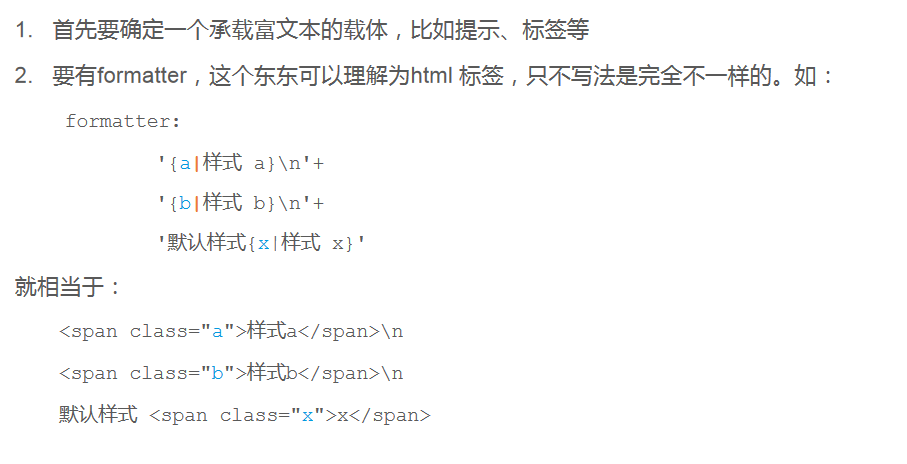

<!DOCTYPE html>
<html lang="en">
<head>
<meta charset="UTF-8">
<title>富文本</title>
<style>
#main{
margin: 20px;
width: 700px;
height: 500px;
}
</style>
</head>
<body>
<!--建立dom 容器-->
<div id="main"></div>
<!--引入echarts-->
<script src="./js/echarts.min.js"></script>
<script>
// 基于准备好的dom,初始化echarts实例
const myChart = echarts.init(document.getElementById('main'));
// 数据
const data=[
{name:'杨戬',value:80,img:'./images/yj.jpg'},
{name:'鲁班',value:60,img:'./images/lb.jpg'},
{name:'沈梦溪',value:40,img:'./images/smx.jpg'},
{name:'诸葛亮',value:30,img:'./images/zgl.jpg'}
];
//获取hero的数据
let hero=data[0];
/*自定义标签 label
* formatter 文本块
* '{样式名|文字内容}\n 换行'
* 文本块的样式
* textBorderColor 文本描边颜色
* textBorderWidth 文本描边宽度
* ...
* rich 富文本,在其中写入样式
* width 宽
* height 高
* backgroundColor 背景色
* image 背景图
* fontSize 文字大小
* lineHeight 行高
* fontWeight 文本加粗
* ...
* */
data.forEach((hero,ind)=>{
hero.label={
formatter:'{img|}\n{name|'+hero.name+'}\n{val|战力:'+hero.value+'}',
textBorderColor:'yellow',
textBorderWidth:2,
rich:{
img:{
width:60,
height:60,
backgroundColor:{
image:hero.img
}
},
name:{
fontSize:16,
lineHeight:28,
fontWeight:'bold'
},
val:{}
}
};
});
/*配置项*/
const option = {
title:{text:'英雄战力'},
series: {
type: 'pie',
data,
radius:'70%',
}
};
myChart.setOption(option);
</script>
</body>
</html>
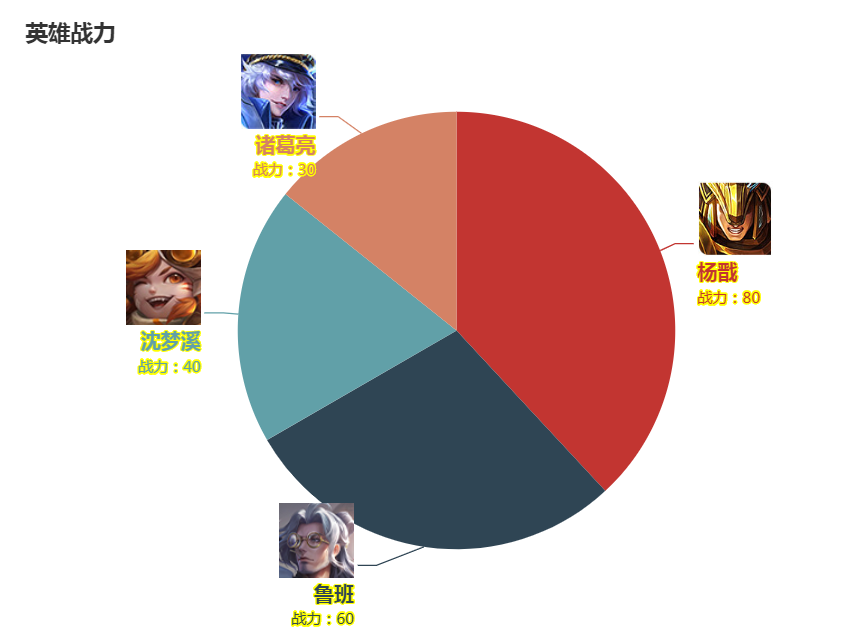
四、原生图形组件
原生图形组件就是可以自定义图形的组件。
原生图形组件里绘制的图形,可以绑定鼠标事件、拖拽事件等。
echarts 有两种点位:坐标位,像素位。
坐标位有直角坐标位、地理坐标位等。
原生图形的位置就是基于像素位定位的。
echarts 实例对象提供了坐标位和像素位的转换方法:
- convertToPixel(坐标系,[x,y]) 坐标位转像素位
- convertFromPixel(坐标系,[x,y]) 像素位转坐标位
案例 – 折线图标记点的拖拽
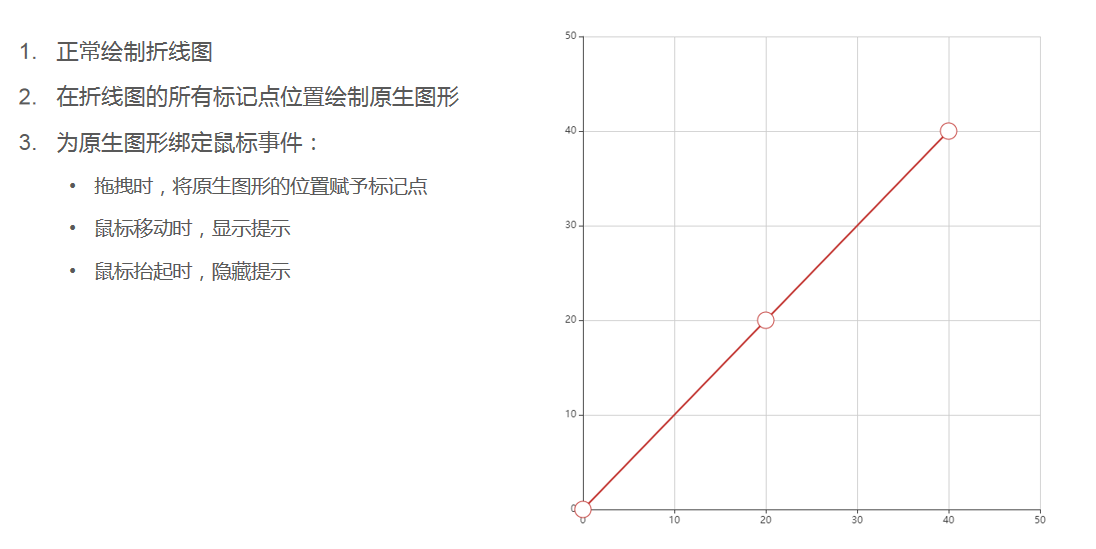
<!DOCTYPE html>
<html lang="en">
<head>
<meta charset="UTF-8">
<title>拖拽</title>
<style>
#main{
margin: 20px;
width: 700px;
height: 700px;
}
</style>
</head>
<body>
<!--建立dom 容器-->
<div id="main"></div>
<!--引入echarts-->
<script src="./js/echarts.min.js"></script>
<script>
/*尺寸*/
const symbolSize = 20;
/*点位*/
const data = [[0,0], [20, 20], [40,40]];
/*实例化echarts*/
const myChart = echarts.init(document.getElementById('main'));
/*1.线绘制折线图*/
myChart.setOption({
/*tooltip 提示
* triggerOn 提示的触发方式
* mousemove 鼠标移动时触发
* click 鼠标点击时触发
* mousemove|click 移动点击皆可触发
* none 不被鼠标移动、点击所触发。可再以后手动触发。
* formatter 格式化提示内容
* */
tooltip: {
triggerOn: 'none',
formatter: function (params) {
return Math.round(params.data[0]) + ' , ' + Math.round(params.data[1]);
}
},
/*x轴
* min,max 刻度区间
* type 坐标轴的类型
* value 数值轴
* */
xAxis: {
min: 0,
max: 50,
type: 'value',
},
/*y 轴
* 属性同x
* */
yAxis: {
min: 0,
max: 50,
type: 'value',
},
/*系列 series
* id 用于在 option 或者 API 中引用组件
* type 类型
* smooth 圆弧
* symbolSize 标记点尺寸
* data 数据
* */
series: [
{
id: 'a',
type: 'line',
smooth: true,
symbolSize: symbolSize,
data: data,
/*itemStyle:{
opacity:0
}*/
}
],
});
/*2.为标记点添加拖拽功能*/
/*graphic 原生图形组件
* type 图形类型,image, text, circle, sector, ring...
* position 位置
* shape 相关于图形的属性,不同类型的图形,其中的属性不同
* onclick 点击事件
* onmousemove 鼠标移动
* */
/*myChart.convertToPixel 将直角坐标系上的点转换为像素*/
/*echarts.util.curry(函数,参数) 函数的柯里化,来自zrender
* 函数中,this 便是event.target
* */
const graphic=data.map((ele,ind)=>{
return {
type: 'circle',
position: myChart.convertToPixel('grid', ele),
shape: {
r: symbolSize / 2
},
invisible: true,
draggable: true,
ondrag: echarts.util.curry(onPointDragging, ind),
onmousemove: echarts.util.curry(showTooltip, ind),
onmouseout: echarts.util.curry(hideTooltip, ind),
z: 100
};
});
myChart.setOption({graphic});
/*鼠标拖拽时,让折线中的点位随拖拽点变化
* convertFromPixel(grid,pos)将拖拽点的像素位解析为直角坐标系的位置
* setOption() 更新数据
* */
function onPointDragging(dataIndex) {
data[dataIndex] = myChart.convertFromPixel('grid', this.position);
myChart.setOption({
series: [{
id: 'a',
data: data
}]
});
}
/*鼠标在标记点上移动时,触发显示提示事件
* type 事件类型,如showTip
* seriesIndex 系列在系列集合中的索引位置
* dataIndex 标记点在系列中的索引位置
* */
function showTooltip(dataIndex) {
myChart.dispatchAction({
type: 'showTip',
seriesIndex: 0,
dataIndex: dataIndex
});
}
/*鼠标在标记点上移动时,触发隐藏提示事件*/
function hideTooltip(dataIndex) {
myChart.dispatchAction({
type: 'hideTip'
});
}
</script>
</body>
</html>
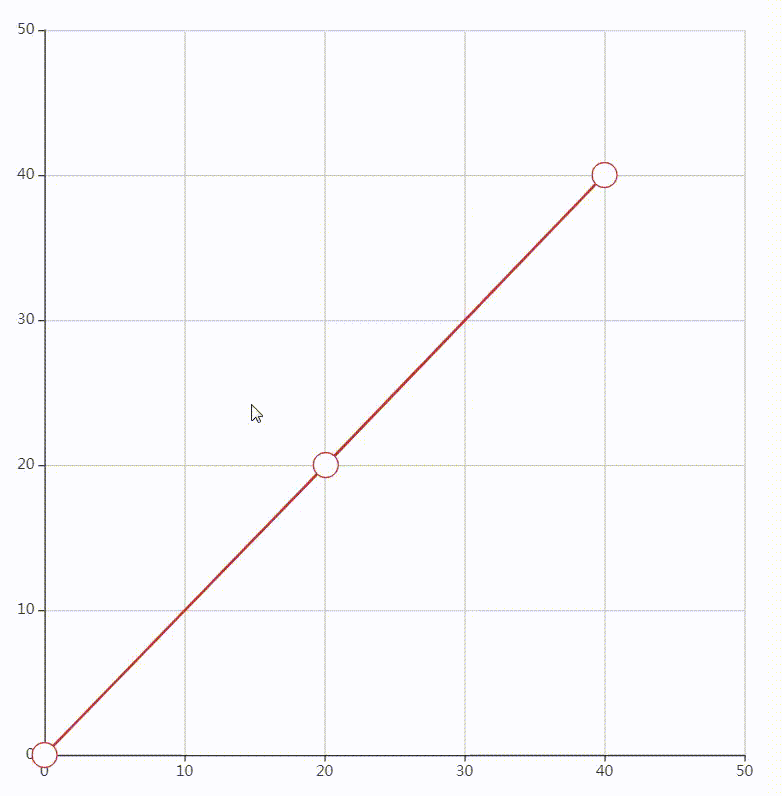
原生图形
<!DOCTYPE html>
<html lang="en">
<head>
<meta charset="UTF-8">
<title>原生图形</title>
<style>
#main{
margin: 20px;
width: 800px;
height: 700px;
background: antiquewhite;
}
</style>
</head>
<body>
<!--建立dom 容器-->
<div id="main"></div>
<!--引入echarts-->
<script src="./js/echarts.min.js"></script>
<script>
/*实例化echarts*/
const myChart = echarts.init(document.getElementById('main'));
/*配置项*/
let option={
/*graphic 原生图形组件
* type 图形类型,image, text, circle, sector, ring...
* position 位置
* shape 相关于图形的属性
* style 图形样式
* draggable 可否拖拽
* onmouseover 鼠标划上
* onmouseup 鼠标抬起
* onmouseout 鼠标划出
* */
graphic:{
id:'c',
type:'circle',
shape:{
r:100
},
position:[300,300],
style:{
fill:'green'
},
draggable:true,
onmouseover:overFn,
onmouseout:outFn
}
};
/*绘图*/
myChart.setOption(option);
/*事件*/
function overFn(){
myChart.setOption({
graphic:{
id:'c',
style:{
fill:'yellow'
},
}
});
}
function outFn(){
myChart.setOption({
graphic:{
id:'c',
style:{
fill:'green'
},
}
});
}
</script>
</body>
</html>

原生图形的位置
<!DOCTYPE html>
<html lang="en">
<head>
<meta charset="UTF-8">
<title>原生图形</title>
<style>
#main{
margin: 20px;
width: 700px;
height: 700px;
background: antiquewhite;
}
</style>
</head>
<body>
<!--建立dom 容器-->
<div id="main"></div>
<!--引入echarts-->
<script src="./js/echarts.min.js"></script>
<script>
/*实例化echarts*/
const myChart = echarts.init(document.getElementById('main'));
/*绘制坐标系*/
myChart.setOption({
/*x轴
* min,max 刻度区间
* type 坐标轴的类型
* value 数值轴
* */
xAxis:{
min:0,
max:50,
},
/*y 轴
* 属性同x
* */
yAxis:{
min:0,
max:50,
}
});
/*绘制原生图形*/
myChart.setOption({
graphic:{
id:'c',
type:'circle',
shape:{
r:100
},
// position:[10,10],
position:myChart.convertToPixel('grid',[20,10]),
style:{
fill:'green'
},
}
});
</script>
</body>
</html>

五、响应式布局
在html 中使用css 中的flex 可以轻松实现响应式布局。
在echarts 里,如何适配不同尺寸的屏幕呢?
- 简单点的可以通过为尺寸、位置等属性设置百分比来实现。
- 复杂些的就需要自定义响应规则。
自定义响应规则的方法
- 建立基础配置项 baseOption
- 建立规则配置列表 media
- 建立query
- 建立此规则下的配置信息option
- echarts 实例基于baseOption 和media 绘制图表
<!DOCTYPE html>
<html lang="en">
<head>
<meta charset="UTF-8">
<title>响应式布局</title>
<style>
html,body{margin: 0;height: 100%}
#main{
height: 100%;
background: antiquewhite;
}
</style>
</head>
<body>
<!--建立dom 容器-->
<div id="main"></div>
<!--引入echarts-->
<script src="./js/echarts.min.js"></script>
<script>
/*实例化echarts*/
const myChart = echarts.init(document.getElementById('main'));
/*基础配置项 baseOption,建立两个绘图区
* grid 绘图区
* xAxis yAxis
* min 最小刻度值
* max 最大刻度值
* gridIndex 绘图区的索引位置
*
* */
const baseOption={
grid:[
{left:'10%',right:'55%',top:'10%',bottom:'10%'},
{left:'55%',right:'10%',top:'10%',bottom:'10%'},
],
xAxis:[
{min:0,max:50,gridIndex:0},
{min:0,max:50,gridIndex:1},
],
yAxis:[
{min:0,max:50,gridIndex:0},
{min:0,max:50,gridIndex:1},
],
};
/*media 规则配置列表
* query 规则,如maxWidth: 768
* option 配置项
* */
const media=[
{
option:{
grid:[
{left:'10%',right:'55%',top:'10%',bottom:'10%'},
{left:'55%',right:'10%',top:'10%',bottom:'10%'},
],
}
},
{
query:{
maxWidth:768
},
option:{
grid:[
{left:'10%',right:'10%',top:'10%',bottom:'55%'},
{left:'10%',right:'10%',top:'55%',bottom:'10%'},
],
}
}
];
/*绘图*/
myChart.setOption({baseOption,media});
/*窗口尺寸发生变化resize 时,echarts 实例使用resize() 方法重置尺寸*/
window.addEventListener('resize',function(){
myChart.resize();
})
</script>
</body>
</html>

注:课程来自开课吧
越是迷茫、浮躁的时候,保持冷静和耐心,尤为重要


